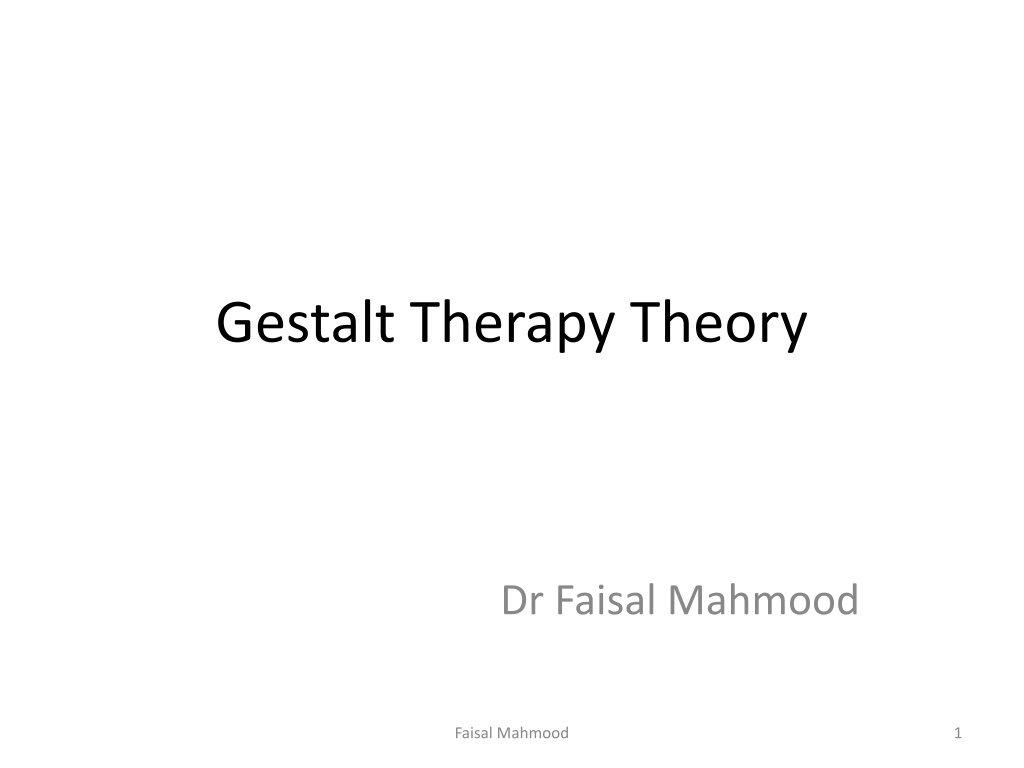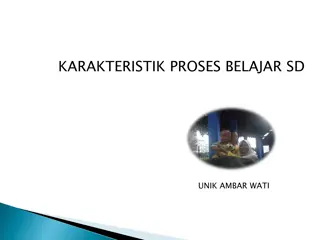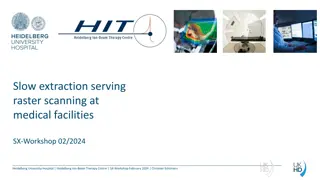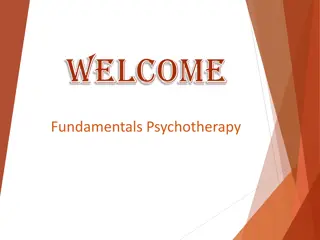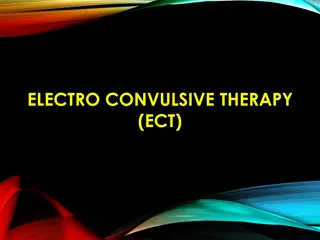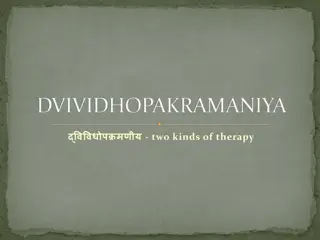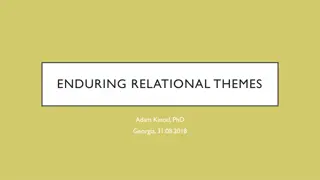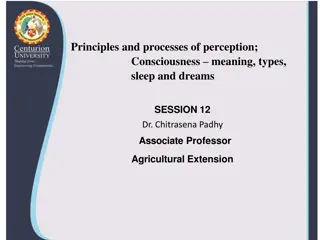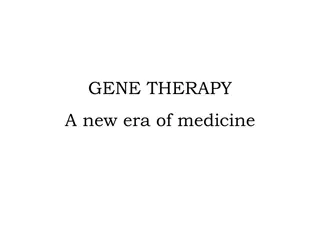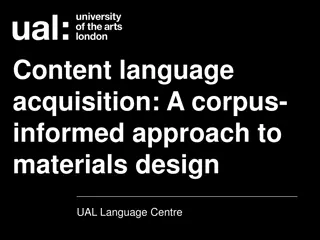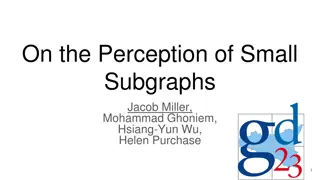Understanding Gestalt Therapy Theory with Dr. Faisal Mahmood
Explore the basic concepts of Gestalt therapy theory with Dr. Faisal Mahmood. Delve into phenomenology, field theory, and dialogical relationship. Learn the holistic, process-oriented, and existential approach to human change focused on awareness and personal responsibility.
Download Presentation

Please find below an Image/Link to download the presentation.
The content on the website is provided AS IS for your information and personal use only. It may not be sold, licensed, or shared on other websites without obtaining consent from the author. Download presentation by click this link. If you encounter any issues during the download, it is possible that the publisher has removed the file from their server.
E N D
Presentation Transcript
Gestalt Therapy Theory Dr Faisal Mahmood Faisal Mahmood 1
Aims To explore the basic concepts of Gestalt therapy theory. To reflect on theory in relation to ourselves. To introduce the key concepts of Gestalt therapy theory: Phenomenology, Field theory and Dialogical relationship Faisal Mahmood 2
Plan Day 1 10:00 10:30 Check in 10:30 11:30 Introduction to GTT 11:30 11:45 Break 11:45 13:00 Phenomenology 13:00 14:00 Lunch 14:00 15:30 Field Theory 15:30 15:45 Break 15:45 17:00 Experiential Group Work Faisal Mahmood 3
Plan Day 2 10:00 10:30 Check in 10:30 11:30 Dialogical Relationship 11:30 11:45 Break 11:45 13:00 Contact + Modification 13:00 14:00 Lunch 14:00 15:30 Experimentation 15:30 15:45 Break 15:45 17:00 Experiential Group Work + Ending Faisal Mahmood 4
About me Individual and Group Psychotherapist UKCP Approved Supervisor UKCP and BACP Accredited Therapist Head of Subject - Counselling & Psychotherapy Newman University, Birmingham Modality Gestalt and Integrative Trainer Researcher Faisal Mahmood 5
Gestalt Approach Key contributors Fritz Perls and Laura Perls Faisal Mahmood 6
Historical Roots Psychoanalysis Gestalt psychology Field theory Phenomenology Existential philosophy Psychodrama Eastern spiritual traditions 8
Gestalt German word Gestalt is not easily translated into a single English term. It embraces such a wide variety of concepts: the shape, the pattern, the whole form, the configuration. Faisal Mahmood 9
Gestalt therapy is a holistic, process-oriented, dialogical, phenomenological, existential, and field theoretical approach to human change with the centrality of contact, awareness, and personal responsiveness and responsibility. The person is never reduced to parts and structural entities but viewed as an integrated whole with innate potential of growth and mature self-expression (Yontef, 1993). Faisal Mahmood 10
Gestalt Approach Robert Resnick https://www.youtube.com/watch?v=lggz_4oi8r0 From 6.40 Faisal Mahmood 11
The aim of GTT is to raise AWARENESS The three pillars of Gestalt (Yontef, 1993) Phenomenology Dialogue Field Theory 12
Gestalt Approach 3 Pillars Field theory: the person s experience is explored in the context of their situation/field. Phenomenology: the search for understanding through what is obvious and/or revealed, rather than through what is interpreted by the observer. Dialogic Relating: a specific form of contacting (not just talking) that is concerned with the between of the relationship and what emerges in that between. Faisal Mahmood 13
The Whole is More Than the Sum of Its Parts Faisal Mahmood 14
The Whole is More Than the Sum of Its Parts A family is made up of separate members, each with individual psychology. One could analyse each of them without seeing the others But the way in which the family operates as a systemic whole is uniquely more than, and different from, the sum total of the individual psychologies of the family members. Faisal Mahmood 15
Key Concepts in Gestalt Therapy Self as process as a verb not a noun. Selfing - takes place in the between of relationship, with self- experienced through contact taking place at the contact boundaries Figure and ground - figures are constantly emerging from the background as we organise the field according to here and now needs. Historic experience can limit/influence figure formation Faisal Mahmood 16
Key Concepts in Gestalt Therapy Creative Adjustment is the process of adaptation to the situation we inhabit in terms of our being in the world via our ability to modify how we behave, think, feel, move towards/away from interest depending on the support/lack of support felt Paradoxical Theory of Change: change is seen as the result of supporting awareness : one becomes what he is; not when he tries to become what he is not (Beisser 1971) Creative Indifference: originating in Zen, the therapist holds a position on non-attachment, supporting the client to creatively (re)adjust, not preferring one outcome over another Faisal Mahmood 17
Gestalt Approach.... A person is a whole and is (rather than has) a body, emotions, thoughts, sensations and perceptions all of which function inter- relatedly. A person is part of their environment and cannot be understood apart from it. People are proactive rather than reactive. They determine their own responses to the world. Faisal Mahmood 18
Gestalt Approach.... People are capable of being aware of their sensation, thoughts, emotions and perceptions. People, through self-awareness, are capable of choice and therefore responsible for their behaviour. People possesses the potential and resources to live effectively and to satisfy their needs. Faisal Mahmood 19
Gestalt Approach.... People can experience themselves only in the present. The past and the future can be experienced only in the now through remembering and anticipating. People are neither intrinsically good or bad. Faisal Mahmood 20
Gestalt Approach HOW individuals behave in the present moment is far more crucial to self understanding than WHY they behave as they do. Faisal Mahmood 21
Therapeutic Goals.. The aim of the Gestalt approach is for a person to discover, explore and experience their own shape, pattern and wholeness. The aim of the Gestalt is the integration of all different parts. In this way people can let themselves become totally what they already are, and what they potentially can become. Faisal Mahmood 22
The lived present holds a past and a future within its thickness (Merleaue-ponty, 1962) Faisal Mahmood 23
Self Vs Selfing Faisal Mahmood 24
Perls et al. (1951, p.iv) Faisal Mahmood 25
Phenomenology Faisal Mahmood 26
Phenomenology Trying to stay as close to the client s experience as possible, To stay in the here-and-now moment And rather than interpreting the client s behaviour to help him explore and become aware of how to make sense of the world Faisal Mahmood 27
Phenomenological Method Husserl (1859-1938) Bracketing Description Horizontalisation Faisal Mahmood 28
Phenomenological method - Bracketing This is an attempt to identify and acknowledge the preconceptions, judgements and attitudes that the counsellor inevitably carries into the therapeutic relationship. It helps to start from a deliberate attitude, that your opinions and judgements are suspect and that you need to wait before you reach any conclusion. Faisal Mahmood 29
Phenomenological method - Bracketing Allow the meaning of the situation emerge . How do you feel about that? or What does that mean for you What sense do you make of that? . How did that happen? You are allowing the meaning of the situation to emerge. Faisal Mahmood 30
Spinelli (2005) An Interpreted World To set aside or to bracket any biases, judgements, prejudices, assumptions and expectations in order to focus on the primary and immediate data of our experiences (Spinelli, 2005). It is not humanly feasible to bracket all our biases or assumptions, however, we are certainly capable of bracketing to a great extent as well as acknowledging our biases reducing their impact on our immediate experiences. Faisal Mahmood 31
Example (Joyce & Sills) James: I ve just found out my partner is pregnant and she is so pleased. [Couns reaction - Feels an immediately positive response but hesitates] Couns response: How is that for you? (Brackets her own values and reactions) James: I don t know really. I m pleased of course. [Couns reaction starts to sense some emotion other than pleasure concern or worry perhaps?] Couns response: Is there some other feeling or concern about having a baby? (Brackets her emerging judgement and investigates what may be unspoken. ) James: It s fine. But I m worried about bringing a child up in such difficult times. Faisal Mahmood 32
Phenomenological method - Description This involves staying with the awareness of what is immediately obvious and describing what you see. While the counsellor is bracketing off her assumptions and values, she confines herself to describing what she notices (sees, hears, senses, etc.) Faisal Mahmood 33
Phenomenological method - Description Description Typical interventions: I m noticing that .(your breathing has speeded up) You seem to be saying ..(that this is very important to you) You look .(distressed) I m aware that you ve .(arrived 10 minutes late) Faisal Mahmood 34
Description (Spinelli, 2005) To suspend our desires to explain the other. To avoid limiting our experience of the other by instantly attempting to make sense or explain it on the basis of our hypothesis. To focus on description instead of theoretical reasoning in order to achieve concretely based descriptive investigation of our intentional biases which make up our experience. Faisal Mahmood 35
Phenomenological method - Horizontalisation Everything that happens is potentially as important (horizontal) or equal as anything else. Faisal Mahmood 36
Phenomenological method - Horizontalisation To avoid assigning any initial hierarchies of importance upon the items of our descriptions, and instead to treat each initially as having equal value or significance (Spinelli, 2005, p.21). We set aside our preconceptions about what kinds of data are more significant than other kinds, thus remaining open to the possibility that some factors will prove upon examination to be more significant than we might formerly have thought (Crocker, 2009, p.22). Faisal Mahmood 37
Therapy of the Situation Field perspective Faisal Mahmood 38
Trees can not be independent of the ground of environmental influences in which they are rooted. Wertheimer believed that the individual is an outgrowth of his situational conditions. Faisal Mahmood 39
World Person World Person Faisal Mahmood 40
Gestalt Therapy Figure and Ground perception Faisal Mahmood 41
Gestalt Therapy Theory Faisal Mahmood 42
A Gestalt therapist must have a relational awareness of the total situation (Perls, 1973). Field theory / Therapy of the Situation Faisal Mahmood 43
Dynamic interplay of the human being and his phenomenal environment, the dynamic person- world interaction. Therapy of the Situation Person part of a larger whole. Gestalt therapist defines personal problems in terms of the interactional whole consisting of the person and his world. Wollants (2012) Faisal Mahmood 44
Therapy of the Situation Psychological distress = unsupportive field / disturbed person-world interaction. The person is not a disturbed body, nor a disturbed soul; it s the disturbed interplay of person and his environment. Faisal Mahmood 45
Developmental concepts Self-support is impossible without environmental support. Regression contrasting view: an adaption that is needed in order to make the world smaller so that it can accommodate diminishing abilities. Regression can be Progression! The parents themselves have to develop in order to cope with the process that is unfolding between them and their child. (Wheeler, 2002) Support is what enables the next step to be taken. (Laura Perls, 1992) Faisal Mahmood 46
Mental disorders are coping mechanism. Shifting from a monopersonal paradigm to a situational, relational paradigm, a Gestalt-theoretical approach also shifts from a paradigm of pathology based on intrapsychic conflict and defence to an interactive conception of psychotherapy. Both normal and abnormal reactions are ways of dealing with the situation. They are simply poles of continuum, a way of coping with a difficult and frightening situation. Diagnosis of the situation A Gestalt-therapeutic diagnosis is a field diagnosis. Faisal Mahmood 47
Summary I am always a part of the situation. My environment and I constitute a whole. My development as a person and my concrete behaviour can be understood properly only as a function of the total situation. I am not the only part of a situation; I am always part of a situation together with other people. As regards the creation of a balance between forces arising from the person and other forces arising from the experienced environment, the others and I depend on one another. When this interactional dynamic balance is hindered, difficult or impossible, the situation becomes disordered for the parts involved. Mental disorders are related to a disturbance of the creative adjustment of the between Wollants, 2012, Pp.15-16 Faisal Mahmood 48
Experiential exercise My field conditions Me People, objects and experiences that impact my present moment / my contact with others Closer to the centre = stronger influence 49
Therapist Client Dialogic relationship A co-created encounter (Incorporating totality of the whole field) Faisal Mahmood 50
